Whether you’re riding in a local unaffiliated dressage test or heading to a Horse of the Year Show qualifier, washing and bathing your horse takes up plenty of time. And when you arrive in the morning to find a self-made skewbald rather than the gleaming grey you said goodnight to, it often feels like all that effort is wasted.
As Becky Godfrey-Faussett, managing director of Snuggy Hoods, explains: “Horses who live outside and those on deep litter bedding are going to be a little harder to keep clean than those kept in on frequently cleaned bedding. The use of hoods and rugs can help, especially as some can be used both inside and outside to protect the areas that are not covered by rugs, like the belly.”
But in the summer heat, it gets trickier. How can you keep your horse clean without them overheating?
Choose the right rug for the weather
Chantal Ball from Premier Equine explains: “Your horse’s needs and the current weather conditions will dictate what type of rug is best to use to keep your horse clean during warmer months. For horses who are turned out, we recommend a lightweight turnout rug with the appropriate amount of fill for your horse.”
Chantal added that rugs are available in lightweight fills — from 0g no fill as well as 40g and 50g.
Former racing groom, Loren Delosa, is based in Melbourne, Australia, so she’s up against high temperatures and plenty of dust — which instantly dulls even the shiniest of coats. Loren pays strict attention to the type of material her rugs are made from, as well as keeping rugs clean.
“In the hot weather – over 30 degrees – I use a rug made from fine plastic mesh. It’s really breathable and gives almost 100% UV protection.”
Stable stains can cause the biggest headache for owners of grey and coloured horses.
“For keeping horses cool and clean in the stable we recommend choosing a rug with material that is moisture wicking and breathable,” says Chantal. “Our stable sheets are crafted with technical polyester which wicks away moisture and keeps horses dust-free, and our waffle range is crafted from an advanced fabric weave construction which provides superior breathability and the smooth formation of the fabric will not hold dust or shavings.”
Abby Barker at WeatherBeeta emphasises the need for summer-specific rugs: “A summer sheet range is the perfect choice to keep your horse clean and protected before competitions during the summer months. They offer a great alternative to traditional turn-outs, mesh or stable rugs as they are so lightweight.”
Louise Ainge at Shires recommends the use of rugs that contain wick-away properties, so it’s easier to wash your horse before travelling. So, even if you do need to bath before a show, you’ll turn up with a clean and dry horse. Louise adds: “if it’s an extremely hot day or your horse heats up while travelling, we recommend no rug and leaving enough time to do final touch-ups when you reach your destination.”
Louise goes on to discuss material choice for rugs: “Loosely-woven fabric that allows air to flow is ideal. A combination of mesh sides and a more densely-woven top layer keeps the air flowing but prevents dust from settling, and protects against sun bleach.”
Take advantage of fly rugs
Using lightweight rugs, like sweet-itch and fly rugs, can help keep horses clean and comfortable. Becky talks about how their summer range of anti-itch products form a thin barrier against both dirt and stable muck, as well as from bugs and fly bites.
“We find that most horses wearing our combos are happy to stand out in the hottest of weather, as they aren’t being driven mad by the bugs.”
Claire Nulty from Bucas echoes this: “Fly rugs are another great alternative, designed to keep your horse protected, the rug will keep the horse clean, comfortable and fly-free. They will also help protect your horse’s coat from sun damage and bleaching, which is especially important in the show ring.”
Louise discusses how to use fly rugs to protect against dirt and muck.
“Fly rugs can do a reasonable job of keeping a horse clean. Go for a smaller/finer-holed mesh — this will give better protection. However, the lightweight nature of fly rug fabric means they are not an ideal choice against dirt and stains. Our more densely woven sweet-itch rugs are a better choice and the ripstop fabric is harder wearing. Overall, fly rugs are there to protect against bugs/flies — and there will always be that one horse who manages to cover itself in dirt regardless of what you put on them!”
However, fly rugs in the stable may not offer the right protection against dirt, explains Chantal: “The weave structure and mesh materials could allow dirt to migrate through to the horse’s coat.”
For stable use, lightweight sheets made from breathable, wicking materials may be a better option.
It’s welcome news for the owners of grey horses, who can avoid the endless baths and washing.
“Horses normally take a few days to adapt to being covered up, shedding a layer of coat while adapting,” explains Becky.
Owners of grey horses may need more protection when their horses are turned out too.
“If the horse is turned out, to keep their legs clean we would recommend using turnout boots,” says Chantal. “Our turnout boots provide support, help prevent injury and are made from specialist Air-Tech ventilated neoprene, keeping your horses legs cool for up to 12 hours during turnout. These will provide protection against dirt and dust – keeping your horses legs clean.”
Get into a regular grooming routine
For those who can’t rug, work on thoroughly grooming the coat. Freelance groom and eventer, Zoey Carroll, spent three years working in a tack shop, which she attributes to her wide range of products and feed. Her recipe for keeping horses clean is holistic, looking at everything from grooming routines to feed.
“Using products such as NAF Silky/Shiny can help take away scurf, dirt and attempt to keep the stains at bay,” says Zoey. “I try not to shampoo stains too often, especially if they get stains in the same places. This can strip the coat of natural oils which is essential for them, and helps to stop the stains soaking in so permanently. Instead, I leave shampooing for show day.”
The type of shampoo you use can also make it easier to remove stains.
“I have found that medicated shampoo — any brand from a tack shop — tends to clean the skin as well as the coat more efficiently than other products,” says Zoey. Loren has found success with other products too: “I use woolwash to bath my horses. It’s super-sensitive, and while not a proper ‘horse’ wash, I think it does a much better job than anything else I’ve tried and spent a lot of money on!”
Everyday grooming makes a big difference too. Zoey gives the details of her routine: “They get a general brush off, and then coat shine sprayed on a firm body brush to lift off any dirt and scurf. They also get a hot cloth with lavender or skin wash once a week, as I don’t always have access to hot water or a solarium.”
Use easy-to-clean materials
Using lightweight fly rugs can keep the worst stains at bay, but if not cared for properly, these rugs can cause other issues.
“A rugged horse will produce more grease than one without rugs,” says Becky. “We recommend that any under layers are washed in the machine to prevent a build-up of grease. Items should be easy to machine wash regularly too!”
Loren uses light, natural materials for a similar reason: “I love using cotton or natural fibres as they breathe and prevent sweating. I use either cotton or moleskin as under rugs, and because they’re lightweight, they easily fit in the washing machine. It’s so important to always wash your rugs, otherwise they get clumps of hair and scurf, and rub and cause more issues.”
Zoey also recommends washing rugs regularly, as well as any other materials that come into contact with your horse’s skin: “I find if you leave one rug on all the time there’s more of a tendency to rub shoulders and irritate the skin. Likewise, keeping tack, saddle cloths and boots clean and regularly washed to stop old sweat and scurf sitting on their skin is also key.”
Chantal comments on the material that some of Premier Equine’s lighter rugs are crafted from: “It’s a breathable 840D ballistic nylon that keeps your horse cool and helps to regulate their temperature. This is a versatile option as our rug liners can be added when needed for extra warmth when the weather is cooler.”
Claire explains how Bucas uses certain materials to keep horses cool and comfortable: “The rug is developed to cater for both rain and sunshine. It keeps the horse dry and comfortable thanks to the no fill lining and mesh that helps circulate air. The Teflon outer shield helps reduce the UV and the sun-reflective silver colour helps reduce overheating.”
Article continues below…
You might also be interested in:

How to remove stable stains and keep a grey horse clean

Subscribe to Horse & Hound magazine today – and enjoy unlimited website access all year round
Create a natural shine using feed
While feed won’t make that glorious stable stain on your grey disappear, the right feed gives you a better foundation to work with. “I do find that feed has a lot of input in the way a horse’s skin sheds and holds dirt,” says Zoey. “If you get the correct feed for your horse, they should look sleek and shiny before and after they’ve had a groom!”
It’s the same in the southern hemisphere, as Loren explains: “I really think that proper feeding helps keep coats in good condition, so I love food rich in fatty oils. I think if your horse is healthy from the inside out it really shows on their coat.”
For all the latest equestrian news and reports, don’t miss Horse & Hound magazine, out every Thursday.



